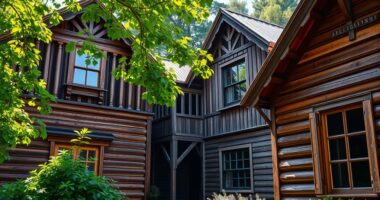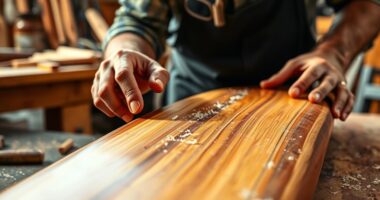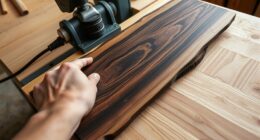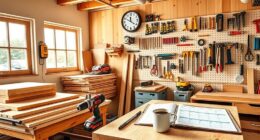Wooden skateboards are an eco-friendly choice that blends performance with sustainability. Made from natural materials like reclaimed maple or bamboo, they offer resilience, flexibility, and unique grain patterns. Using recycled and eco-conscious supplies diminishes waste and helps conserve resources. Plus, craftsmanship and eco-friendly practices guarantee durability without harming the environment. If you want to explore how these boards support greener skateboarding, there’s plenty more to discover about innovative materials and sustainable construction.
Key Takeaways
- Wooden skateboards use sustainable materials like reclaimed maple and bamboo, reducing environmental impact.
- They feature eco-friendly adhesives and coatings that enhance durability while supporting green manufacturing.
- Reclaimed and recycled wood extends deck lifespan, minimizes waste, and promotes a circular economy.
- Bamboo, a fast-growing renewable resource, offers strength, flexibility, and a lower ecological footprint.
- Craftsmanship emphasizes eco-conscious practices, combining performance with environmental responsibility in skateboard construction.
The Appeal of Wooden Skateboards in Modern Skating
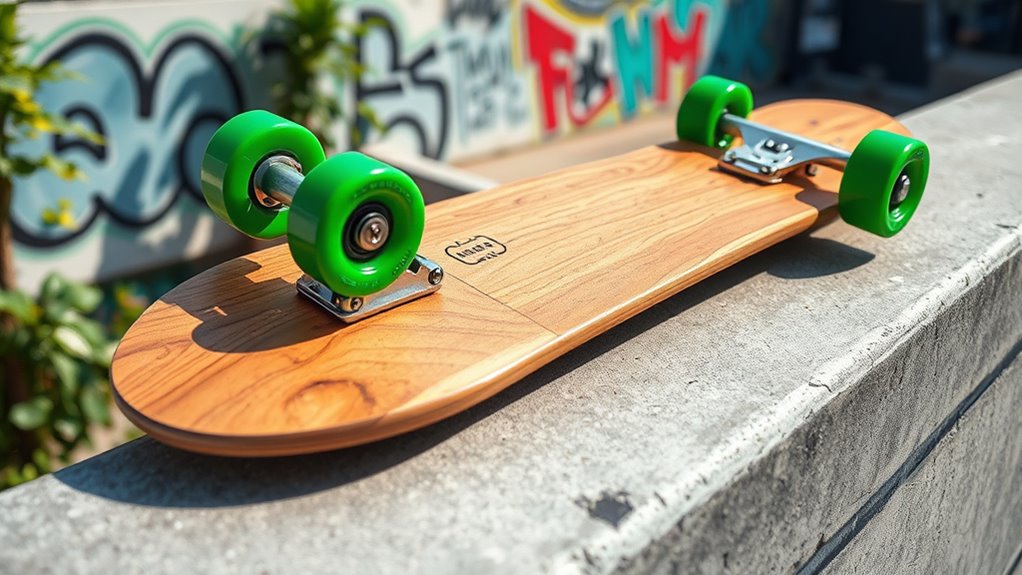
Wooden skateboards have become increasingly popular in modern skating because they combine performance with environmental consciousness. You’ll notice that wooden decks are crafted from natural materials like maple and bamboo, which are both durable and flexible. These eco-friendly options showcase unique grain patterns, making each skateboard a one-of-a-kind piece of art. By choosing sustainable wood or reclaimed materials, you help reduce environmental impact and support a more environmentally conscious skateboarding industry. Wooden skateboards not only deliver high performance for various skating styles but also embody a commitment to sustainability. Their aesthetic appeal enhances your connection to skateboarding’s cultural roots while promoting eco-friendly practices. Additionally, the use of natural materials in construction ensures a lighter, more responsive ride that appeals to many enthusiasts. Employing sustainable practices in manufacturing further minimizes ecological footprints, and fostering a mindful approach to production can inspire broader creative approaches within the industry. This blend of style, function, and environmental responsibility makes wooden skateboards increasingly desirable among enthusiasts. Moreover, incorporating environmentally friendly materials can help mitigate the impact of deforestation, making the industry more sustainable for future generations.
Sustainable Materials Behind Eco-Friendly Skateboards
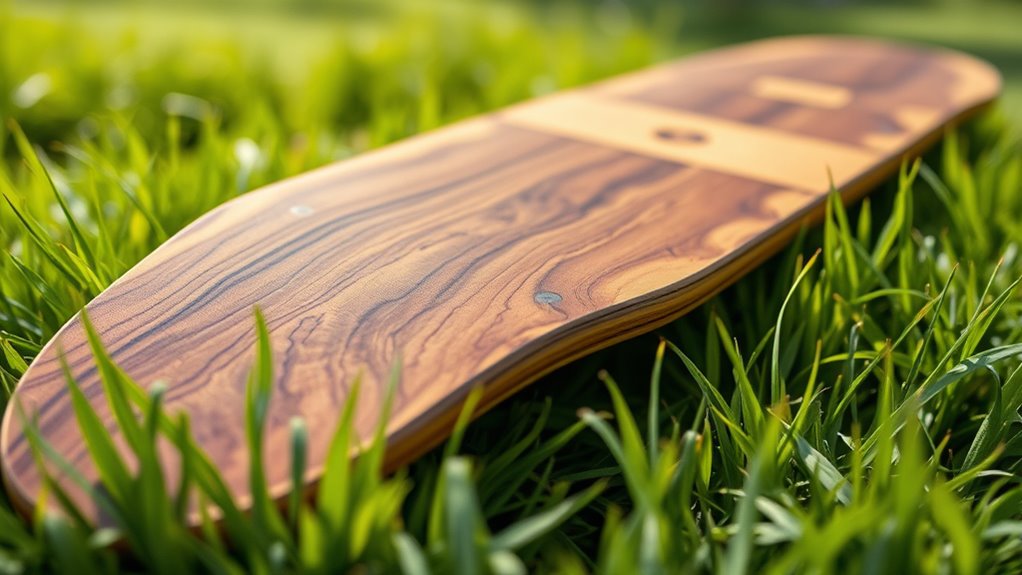
You can choose skateboards made from reclaimed North American maple, which helps reduce waste and conserve resources. Bamboo is also a popular option because it’s fast-growing, strong, and eco-friendly compared to traditional woods. These sustainable materials, combined with eco-conscious adhesives, create durable skateboards that support environmental responsibility. Incorporating pet hair management techniques into board manufacturing can further reduce waste from excess materials and improve overall sustainability. Additionally, utilizing eco-friendly coatings can enhance the skateboard’s durability while maintaining an environmentally conscious approach. Employing sustainable manufacturing practices can also minimize the environmental impact of skateboard production, making these eco-friendly options even more beneficial. Furthermore, maintaining emotional alignment throughout the manufacturing process can promote a positive and mindful work environment, aligning production practices with eco-conscious values. Implementing soil health management strategies in manufacturing facilities can further enhance sustainability and promote eco-friendly production standards.
Reclaimed Skateboarding Wood
Have you ever considered how skateboarding’s waste can be transformed into something useful and sustainable? Reclaimed skateboard wood, often sourced from used decks, is repurposed into stylish, eco-friendly skateboards and accessories. This process supports the circular economy by extending the life of skateboarding decks and reducing landfill waste. Using recycled skateboard decks decreases the demand for new timber, helping conserve forests and prevent deforestation. The durability and unique grain patterns of repurposed wood make each product distinctive. Eco-conscious skateboarders value this environmental responsibility, blending skate culture with sustainability. Companies showcasing reclaimed skateboard wood highlight their commitment to sustainability while offering innovative products that celebrate creative reuse. Incorporating these practices also fosters a safe space for expressing feelings within the skateboarding community, emphasizing shared values of environmental stewardship. Additionally, utilizing reclaimed materials can serve as an educational tool to raise awareness about environmental impact and promote sustainable practices among enthusiasts. Moreover, embracing alternative materials aligns with the growing interest in eco-friendly innovations across various industries. Furthermore, the natural qualities of reclaimed wood contribute to the overall durability and aesthetic appeal of the finished products, appealing to environmentally conscious consumers. Recognizing the sustainability benefits of recycled skateboarding wood encourages more companies to adopt eco-friendly manufacturing methods.
Bamboo and Sustainable Fibers
Bamboo and sustainable fibers are transforming skateboard manufacturing by offering eco-friendly alternatives that don’t compromise performance. Bamboo, a rapidly renewable resource, can be harvested in just 3-5 years, making it ideal for sustainable skateboards. Laminated layers of bamboo veneers bonded with eco-friendly epoxy resins create decks that deliver impact resistance, durability, and flexibility comparable to traditional woods. Sustainable fibers like recycled nylon and glass fiber are integrated into the construction to enhance strength and performance while reducing environmental impact. Using recycled materials and biodegradable options minimizes waste and conserves natural resources, supporting a circular economy. Additionally, many eco-friendly skateboards utilize high suction power and durable materials to ensure long-lasting use, further promoting sustainability. The incorporation of biodegradable components in the manufacturing process helps ensure that the entire product lifecycle minimizes ecological impact, aligning with sustainable practices. Moreover, utilizing renewable resources in production reduces reliance on non-renewable materials and lowers the overall carbon footprint of skateboard manufacturing. Incorporating innovative manufacturing techniques can further improve the sustainability and performance of eco-friendly skateboards.
Craftsmanship and Construction of Wooden Skateboards
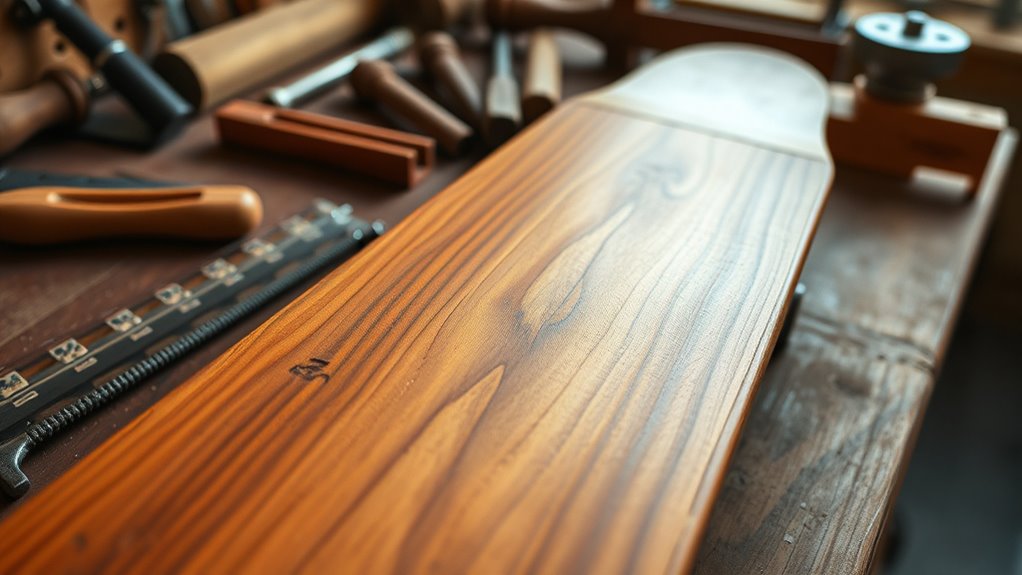
Crafting a wooden skateboard involves a meticulous process that combines precision and skill. The layering process is fundamental, as multiple wood veneers, often North American maple, are glued with epoxy resin to maximize durability and flexibility. You start by shaping the deck, drawing a symmetrical outline, then cutting it with a jigsaw or bandsaw. Next, the edges are rounded and smoothed with a router or sandpaper, enhancing comfort and handling. The layering process ensures structural integrity by orienting the grain perpendicular to strengthen resilience. Skilled craftsmanship is evident in every step, from selecting eco-friendly materials to precise shaping. This construction approach guarantees a lightweight, durable skateboard built for performance, all while maintaining eco-conscious manufacturing practices. Additionally, understanding the weight of wind turbine blades can inspire innovative ways to incorporate sustainable materials into manufacturing processes, emphasizing the importance of eco-friendly manufacturing.
Benefits of Using Reclaimed and Recycled Wood

Using reclaimed and recycled wood helps cut down on material waste and keeps old decks out of landfills. It also conserves natural resources by reducing the need for new timber. Plus, it supports a circular economy, making your skateboard making more sustainable. Additionally, repurposing wood can enhance the unique aesthetic and durability of your skateboard. High fiber content in reclaimed wood can contribute to its strength and longevity. Incorporating automation technology in manufacturing processes can further improve efficiency and quality control in recycled skateboard production.
Reduces Material Waste
Reclaimed and recycled wood considerably reduce material waste by giving used skateboard decks a new purpose instead of sending them to landfills. This practice supports material waste reduction and promotes eco-friendly skateboarding. By repurposing reclaimed wood and recycled skateboard decks, you extend the lifecycle of materials, decreasing landfill waste and environmental pollution.
- Reclaimed wood minimizes demand for virgin timber, aiding natural habitat conservation.
- Recycling skateboard wood uses less energy, lowering your carbon footprint.
- Using sustainable materials fosters a circular economy within the industry.
- It encourages environmentally conscious choices that benefit the planet.
Choosing skateboards made from reclaimed wood aligns with sustainable industry practices, helping to reduce waste and preserve natural resources for future generations.
Conserves Natural Resources
By choosing skateboards made from reclaimed and recycled wood, you help reduce the demand for virgin timber, which is essential for conserving natural forests and habitats. Reclaimed wood and recycled wood are renewable resources that support sustainable practices, minimizing the environmental impact of timber harvesting. Using these materials in skateboards prevents waste by giving wood a second life, reducing landfill accumulation. This approach promotes conservation of natural resources and helps protect biodiversity by reducing deforestation. Additionally, recycled wood lowers energy consumption and greenhouse gas emissions compared to harvesting new timber. Supporting eco-friendly products like these skateboards encourages a circular economy within the industry, ensuring that materials are reused and repurposed, ultimately fostering a more sustainable relationship with our environment.
Promotes Circular Economy
Incorporating reclaimed and recycled wood into skateboard production actively supports a circular economy by keeping materials in use rather than discarding them. Using reclaimed wood and recycled wood reduces the demand for new timber, conserving forests and supporting sustainability.
- It prevents waste from ending up in landfills, promoting waste reduction and extending product lifecycles.
- Manufacturing with reclaimed wood lowers energy consumption and carbon emissions, benefiting the environment.
- Recycled wood often requires fewer chemicals, decreasing environmental pollution.
- This approach exemplifies eco-conscious skateboarding by turning waste into durable goods, therefore conserving resources and fostering a truly circular economy.
Comparing Maple and Bamboo in Skateboard Decks
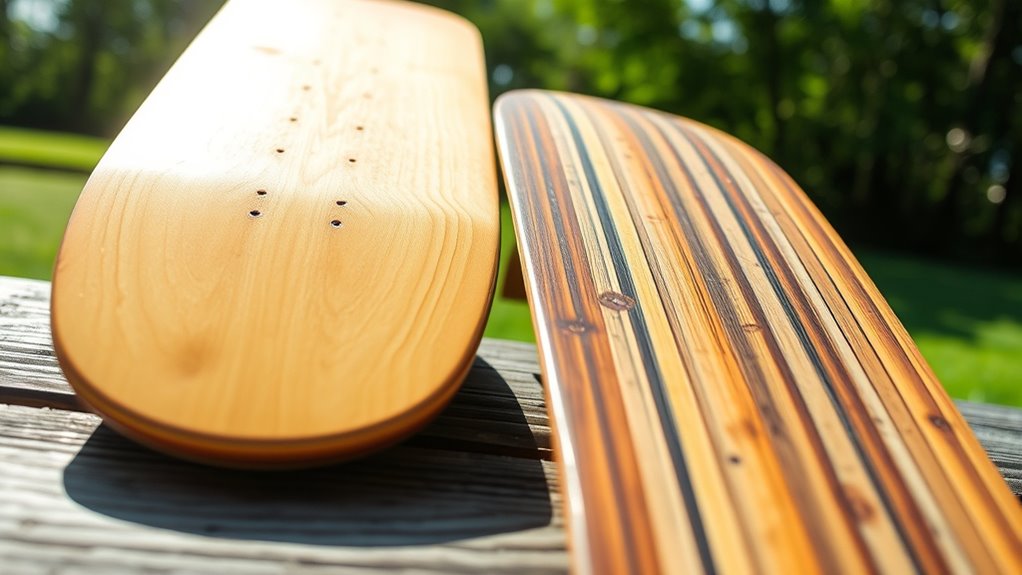
When choosing between maple and bamboo for skateboard decks, understanding their distinct properties can help you make an informed decision. Maple wood, used in traditional skateboards, offers high durability and impact resistance, making it reliable for aggressive riding. Bamboo decks, crafted from rapidly renewable fibers, are naturally stronger and more flexible, providing a lively, responsive ride. They also promote sustainability with faster growth cycles and less water use. To visualize, consider this comparison:
| Property | Maple Decks | Bamboo Decks |
|---|---|---|
| Sustainability | Less renewable | Highly renewable |
| Flexibility | Stiffer, traditional | More flexible, lively |
| Impact Resistance | Durable but heavier | Resilient, shock-absorbing |
Both materials influence your skateboarding experience and environmental impact.
Innovative Uses of Wood in the Skateboarding Industry
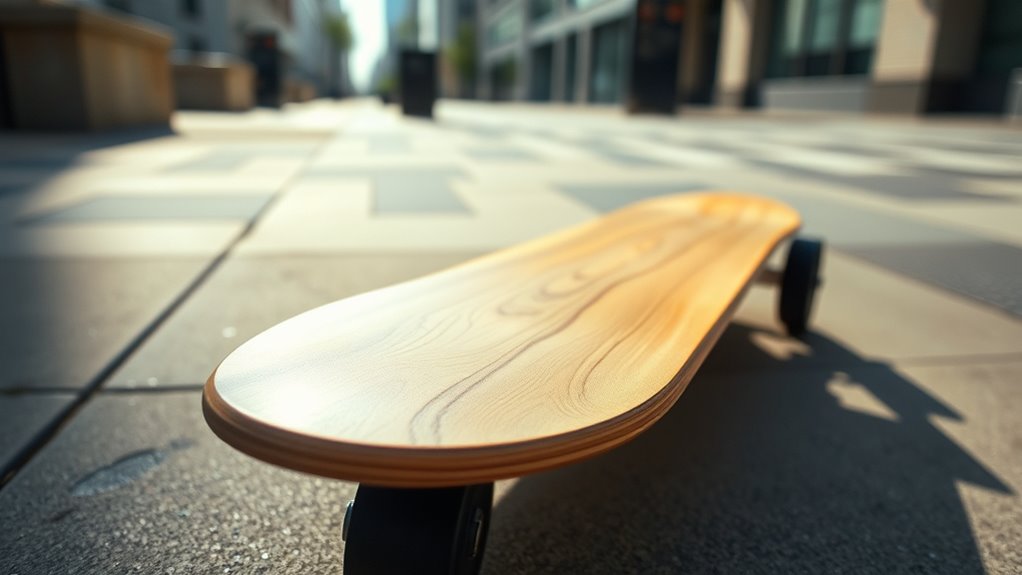
Innovative uses of wood in the skateboarding industry are transforming traditional practices and promoting sustainability. You’ll find that reclaimed skateboarding wood is repurposed into sunglasses, furniture, and accessories, reducing waste and supporting a circular economy.
Reclaimed skateboarding wood is creatively repurposed into accessories and furniture, promoting sustainability and reducing waste.
- Bamboo skateboards harness a rapidly renewable resource, offering strength, durability, and unique natural grain patterns.
- Companies utilize eco-friendly materials like recycled wood and natural grain composites to craft decks with innovative design and reduced environmental impact.
- Wood composites, combining recycled nylon and glass fibers, enhance skateboard components while maintaining sustainability goals.
- Layered construction with sustainable wood, such as North American maple, uses epoxy resin for durability and flexibility, showcasing advanced wood engineering.
These practices exemplify how the industry’s shift toward eco-friendly materials fosters a greener future.
Embracing Eco-Conscious Practices for a Greener Future
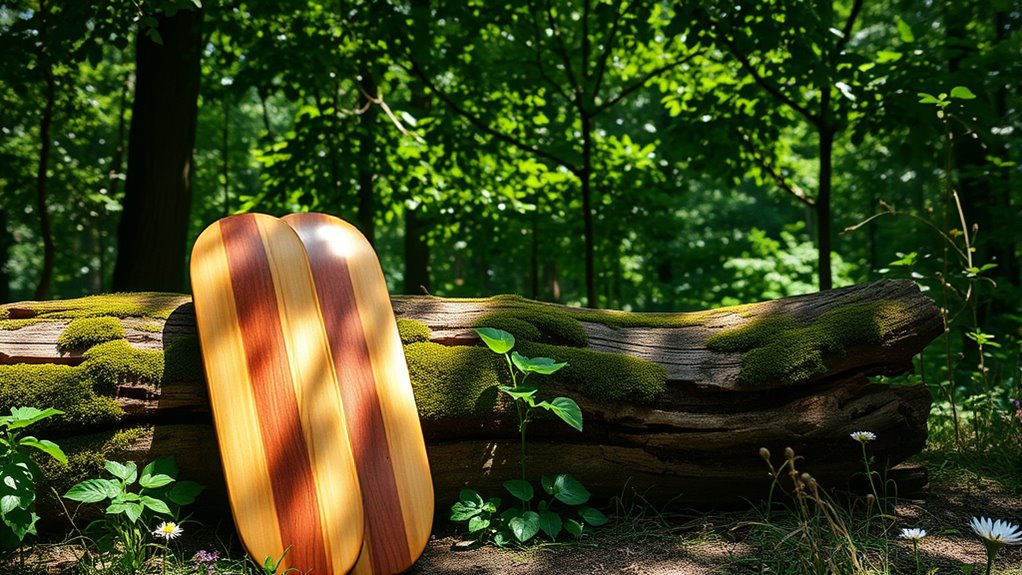
Embracing eco-conscious practices in the skateboarding industry is essential for building a sustainable future. By choosing wooden skateboards made from renewable resources, you support responsible forestry and reduce deforestation. Using reclaimed wood minimizes waste and promotes a circular economy, making your skateboarding eco-friendly. Fast-growing woods like bamboo require less water and pesticides, making them a sustainable choice. Manufacturing with environmentally conscious methods decreases carbon emissions and lessens environmental impact. When you opt for biodegradable materials, you’re helping to reduce plastic waste and pollution. Promoting green practices encourages industry innovation and responsible consumer choices. Ultimately, making eco-friendly decisions in skateboarding not only benefits the planet but also helps create a more sustainable, environmentally conscious future for everyone involved.
Frequently Asked Questions
What Are the Environmental Benefits of Bamboo Skateboards?
You’re asking about the environmental benefits of bamboo skateboards. When you choose bamboo, you support a fast-growing, renewable resource that needs less water, land, and pesticides, reducing deforestation. Bamboo absorbs more CO2, helping lower greenhouse gases. Plus, by reusing or recycling your skateboard, you minimize waste and decrease demand for new materials. Overall, bamboo skateboards offer a greener, more sustainable option that benefits the planet.
Are Wooden Skateboards Good?
You might wonder if wooden skateboards are good, and they definitely are. They’re durable, capable of handling tough tricks and daily rides. They offer excellent shock absorption, making your ride smoother and more comfortable. Plus, if made from sustainable or recycled wood, they’re eco-friendly too. With layered construction, they last longer and stay reliable over time. Overall, wooden skateboards combine strength, style, and sustainability, making them an excellent choice for skaters.
Why Is Canadian Maple Used for Skateboards?
You might wonder why Canadian maple is preferred for skateboards. It’s because this wood offers the perfect mix of strength, flexibility, and durability, helping your board withstand tricks and impacts. Its fine grain allows for precise lamination, making the deck lightweight yet sturdy. Plus, Canadian maple’s uniformity reduces warping or cracking over time. And since it’s sustainably harvested, it aligns with eco-friendly practices, giving you a high-performance, eco-conscious ride.
Are Bamboo Skateboards Good?
Think of bamboo skateboards as the wind beneath your wings—light, flexible, and resilient. Yes, they’re good! They outperform traditional decks in impact resistance, offering durability and a smooth ride. Plus, they’re eco-friendly, growing rapidly and reducing environmental impact. Whether you’re hitting the streets or carving through the park, bamboo decks give you a natural, stylish edge while supporting sustainability. Ride confidently, knowing you’re choosing both performance and the planet.
Conclusion
Imagine gliding smoothly on a wooden skateboard, each ride a step toward a greener future. As you embrace eco-friendly materials like reclaimed wood and innovative designs, you become part of a movement that’s reshaping skateboarding’s future. Will your next trick be on a deck crafted from sustainable sources, blending craftsmanship with consciousness? The choice is in your hands—every ride could be a statement for a more eco-conscious world. Are you ready to roll into change?



